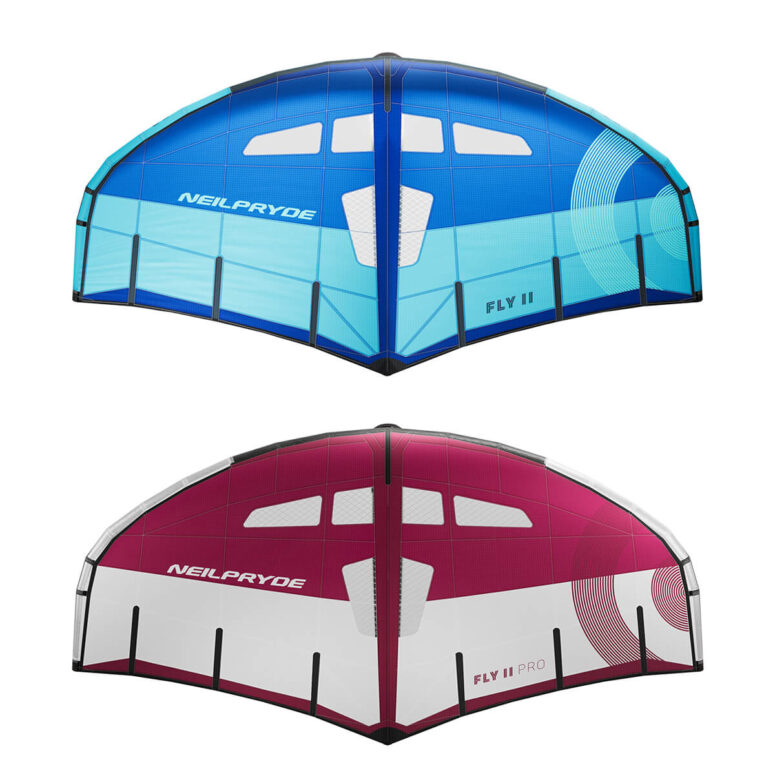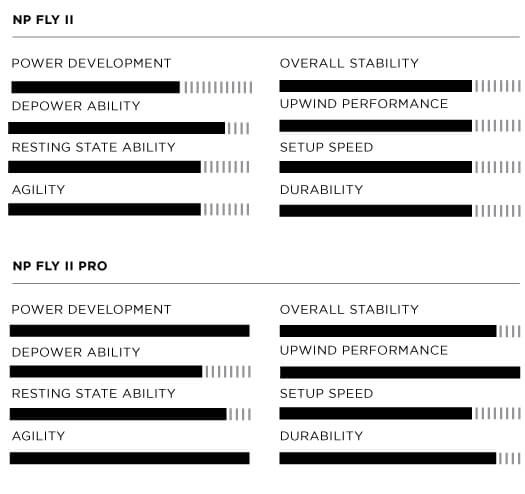

When you purchase gear through links on our site, we may earn a small commission. Here’s why you can trust our tests and our affiliate partner.

We recently had the opportunity to test the latest NeilPryde Fly II and Fly II Pro wings, offering us a fantastic chance to delve into the nuances between two wings that share an almost identical shape but are constructed with very different materials.
First, let's examine the differences between the new models and the previous Fly. This year, the Fly II and Fly II Pro feature significantly reduced diameters in the leading edge (LE) and strut, with the Pro model boasting reductions of up to 12%. This design change allows for higher air pressure and reduced air resistance, enhancing overall performance. Visibility has also been improved with repositioned windows and the addition of two extra ones. The wingtip's increased sweep offers more stability and control in the new model. Overall, the Fly II boasts a more precise shape compared to last year's model. Let's now delve into the differences between the Fly II and Fly II Pro.
Both wings share a similar shape, with the main difference being the materials used in the leading edge and struts. The Fly II utilizes high quality Dacron for its leading edge and strut, with a refined canopy featuring standard 2×2 yarn in the first half, transitioning to a thicker, more rigid and durable material in the middle section and trailing edge. The Fly II Pro, on the other hand, uses the same canopy layout and materials but replaces Dacron in the LE and strut with the latest Aluula materials. Instead of the commonly used Aluula Gold, the Pro features the all-new Aluula Aeris X in the central part of the wing and strut and Aluula Aeris on the wingtips and the final part of the strut.
Keeping up with the latest high-tech materials can be challenging, but Aluula Aeris X stands out with its impressive properties: it is 50% lighter, four times stronger and incredibly tear-resistant. Aeris X’s rigidity transforms the wing's feel and allows for thinner diameters in the LE and strut. The wingtips use the Aeris material, which retains most of the advantages of Aeris X but is less rigid, providing a more flexible feel while maintaining extraordinary strength and tear resistance. How to repair these materials, you may ask? It is straightforward, just using an iron! Both versions feature high quality bladders secured in place with plastic protrusions, preventing frustrating twists.
The handles on both models are crafted from carbon fiber and are strategically positioned to ensure a direct feel in all conditions. At first glance, they appear identical, but testing revealed that the Pro handles are slightly thinner and without any texture, giving a more technical look but perhaps slightly less comfort than the Fly II’s more “spongier’ grips, especially in stronger winds. Both models feature an angled front handle for increased responsiveness, power generation, speed and easier water starts.
So, how do these wings perform on the water? Water starts are effortless with both wings due to their power and compact span, but the Pro excels with no flex in the leading edge or strut and lighter weight, making it superior for generating power and speed. This is particularly advantageous in low winds, allowing the use of a smaller wing for power generation during water starts and riding. The Pro thus offers better low-end performance than the regular Fly II, opening up the option to use a smaller wing during freestyle or wave sessions. However, at the high end, the regular Fly II provides a more comfortable ride for the average rider. The Pro becomes more aggressive, fast, direct and technical, which, combined with its harder handles, makes the ride more intense and sharp… ideal for freestyle but less so for average freeriders. Both wings offer excellent upwind riding, though we noticed that the Pro provides a slightly better angle. They are also very stable and offer minimal resistance during transitions even in our sessions looking for the high-end of the wings, offering a great riding experience under all different conditions.
We had some great wave sessions, showing us that both wings are easy to flag out and follow effortlessly behind, performing well in small to medium waves. They both fly neutrally behind you and the vented strut prevents weird movements while surfing or carving. Both wings adapt well to various riding styles, making them great for waves or freeride. For freestyle, the Pro is the clear choice, allowing us to ride a smaller wing due to its power delivery and speed. Initially, the Pro's speed and sharpness posed a challenge for us, but with practice, we turned it into an advantage, gaining confidence to attempt and land new moves. The Pro's lift and hangtime are impressive, though it required smaller inputs due to its reactivity. We also noted the Pro's superior landings, thanks to the flexible Aeris material at the tips. On more occasions than we'd like to admit, we landed leaning into the wing and water. This allowed us to observe firsthand how the Aeris material flexed at the tips while the Aeris X in the center remained rigid, resulting in a higher success rate for our landings.
The Fly II ranges from 1.8m to 6.7m with gaps from 0.3m to 0.6m, while the Pro ranges from 3.5m to 6.5m with 0.5m gaps. In practice, we preferred the Pro in low to medium winds and the regular Fly II in medium to high winds for a session across any discipline.
So, who are these wings for? Both models are excellent for any conditions and spots. We enjoyed great downwinders, freeride and freestyle sessions. For the average or new rider, the Fly II is perfect for starting your wingfoil journey and for intermediate riders seeking progression in any discipline or leisurely cruising. The Fly II Pro, however, is designed for intermediate to advanced riders aiming to push their limits. This wing will not hinder your progression, in fact, it will elevate your performance! Returning to our initial point of comparing these two wings back-to-back, the main basic differences are weight and rigidity, both of which favor the Pro model. Think of it like upgrading from a good bike to one with a carbon fiber frame – that’s a good way to explain the difference between the Fly II and Fly II Pro.
